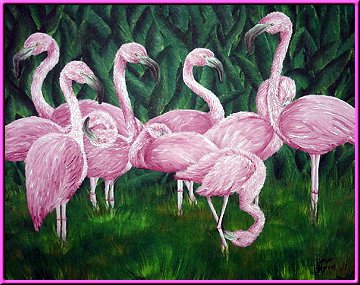
Flamingos are truly great birds! They are unmistakeable is size, shape, color, and those wonderfully bend-me-backwards knees on their long legs. Fossil evidence of Flamingo-like birds showed they lived about 30 to 50 million years ago. This is before many other avian orders evolved. Some fossilized flamingo footprints, estimated to be seven million years old, have been found in the Andes Mountains. When I read that, I thought, "Cool! Flamingos could be in the Jurassic Park Movie!" Not really, they aren't quite that old, but it gives an interesting mental picture of those people running from giant pink dinosaur-birds that are pecking at their heads!
All flamingos are found in tropical and subtropical areas. The following are types of flamingos, their classifications, where they are found, and some differences in appearances:
- Chilean Flamingo (Phoenicopterus chilensis): Central Peru, both coasts of southern South America (mainly in the winter), Argentina, Uruguay, Paraguay, and southern Brazil. Some have been reported on the Falkland Islands. Chilean flamingos are slightly smaller than Caribbean flamingos and have gray legs with pink bands at the joints.
- Lesser Flamingo (Phoeniconaias minor): Eastern, southwestern, western Africa, some in India. Can be found as far north as southern Spain. This species is the smallest of all flamingos. The color of the lesser flamingo is brighter than the greater flamingo.
- James' Flamingo (Phoenicoparrus jamesi): Southern Peru, northeastern Chile, western Bolivia, and northwestern Argentina. This species is characterized by having all black flight feathers, including the secondary flight feathers, which are red in other species.
- Andean Flamingo (Phoenicoparrus andinus): Southern Peru, north-central Chile, western Bolivia, and northwestern Argentina.
This is the only species of flamingo that has yellow legs and feet. It also has a red spot between the nostrils.
- Greater Flamingo (Phoenicopterus ruber roseus): The most widely distributed of all flamingo species. Found in northwest India, the Middle East, the western Mediterranean, and Africa. Limited numbers of this species can be found over much of northern Europe, eastward to Siberia. It is the largest of the flamingos and has deep pink wings.
- Caribbean Flamingo (Phoenicopterus ruber ruber): Yucatan, parts of the West Indies, Bahamas, Galapagos Islands, the northernmost tip of South America. They also wander to south Florida with the rest of the tourists. The Caribbean Flamingo is slightly smaller than Greater Flamingo listed above, but is actually a sub-species of the Greater Flamingo.

ALL PHOTOS ARE "CLICKABLE" (you know, to see bigger ones)
APPEARANCE: Male flamingos (who reach full size between 1 1/2 to 2 years) are slightly larger than females. They also weigh more and have longer wingspans, but this not a reliable way to identify males from females. The Greater Flamingo is the largest standing 43 to 51 inches (110 to 130 cm) tall and weighing up to 7.7 pounds (3.5 kg). The smallest is the Lesser Flamingo, standing 31.5 inches (80 cm) tall and weighing 5.5 pounds (2.5 kg).  Their wingspans range from 37-39 inches up to 55-65 inches. Flamingo feather coloration ranges from pale pink to crimson according to species, with Caribbean Flamingos have the brightest coloration. Males and females are about the same color, with coloration being derived from carotenoid pigments found in a flamingo's food. Chicks and Juveniles are white to grayish, taking 1 to 2 years to develop full coloration. Parents will lose their pink coloration while raising young if they are still feeding chicks through the adultís molting period. Their wingspans range from 37-39 inches up to 55-65 inches. Flamingo feather coloration ranges from pale pink to crimson according to species, with Caribbean Flamingos have the brightest coloration. Males and females are about the same color, with coloration being derived from carotenoid pigments found in a flamingo's food. Chicks and Juveniles are white to grayish, taking 1 to 2 years to develop full coloration. Parents will lose their pink coloration while raising young if they are still feeding chicks through the adultís molting period.
WHERE THEY LIVE: Flamingos generally prefer large alkaline or saline lakes or estuarine lagoons that usually lack vegetation. The lakes may be far inland or near the sea. This includes mangrove swamps, tidal flats, and sandy islands in the intertidal zone.
Whether there are fish has an influence on the use of some lakes by some flamingos. The Chilean Flamingo prefers not to have fish in the water which would compete for food with them. Flamingos are generally non-migratory birds. But due to changes in climate and water levels  will move their colonies. Populations that breed in high-altitude lakes, which may freeze over in the winter, move to warmer areas. Most will return to their native colony to breed. An interesting fact is that when flamingos migrate, they do so mainly at night. (Giant pink birds flying in large flocks at night could give a kid nightmares!) They (and the rest of the flying public) prefer a cloudless sky with favorable tailwinds. They can travel as far as 373 miles (600 km) in one night at 31-37 mph (50 to 60 kph). Day travel is done at high altitudes to possibly avoid predators. will move their colonies. Populations that breed in high-altitude lakes, which may freeze over in the winter, move to warmer areas. Most will return to their native colony to breed. An interesting fact is that when flamingos migrate, they do so mainly at night. (Giant pink birds flying in large flocks at night could give a kid nightmares!) They (and the rest of the flying public) prefer a cloudless sky with favorable tailwinds. They can travel as far as 373 miles (600 km) in one night at 31-37 mph (50 to 60 kph). Day travel is done at high altitudes to possibly avoid predators.
WHAT THEY EAT: The flamingo's feathers, legs, and face coloration comes from their diet which is high in alpha and beta carotenoid pigments. This sounds a whole lot nicer than saying they eat algae and bugs to become pink. But that is the truth. Specifically they eat blue-green and red algaes, larval and adult insects, crustaceans, mollusks, and small fishes. Different types of flamingos have different diets that vary according to the shape of their bills. The bills on the Lesser, James', and Andean flamingos have deep-keeled bills and they eat mainly algae and diatoms (single-celled plant in a hard shell). Greater, Caribbean, and Chilean flamingos have shallow-keeled bills and feed on insects, aquatic invertebrates, and small fishes. Caribbean flamingos eat larval and pupal forms of flies and brine shrimp as their main food. Naturally they feed while standing in shallow water, and they use their webbed feet to stir up food from the bottom. They search for fresh water for drinking too. The bills on the Lesser, James', and Andean flamingos have deep-keeled bills and they eat mainly algae and diatoms (single-celled plant in a hard shell). Greater, Caribbean, and Chilean flamingos have shallow-keeled bills and feed on insects, aquatic invertebrates, and small fishes. Caribbean flamingos eat larval and pupal forms of flies and brine shrimp as their main food. Naturally they feed while standing in shallow water, and they use their webbed feet to stir up food from the bottom. They search for fresh water for drinking too.
GENERAL CHARACTERISTICS: It is unknown how long they live in the wild, but one flamingo lived for 44 years in the Philadelphia Zoo. Flamingos wade, swim, and fly. They can be spotted in dense packs floating on the surface of water. They like to rest either standing on one leg or sitting down with legs tucked beneath them. And while they rest, they face the wind which keeps the wind and rain from penetrating their feathers. Flying flamingos need a little runway to take off. They take several steps and flap their wings to lift off. When landing they reverse that, needing a little room to slow down since they fly up to 31-37 mph (50 -60 kph)! They fly with their heads and necks stretched out in front and legs trailing behind. The flock flies in long lines.
Flamingos are social birds that live in colonies of tens of thousands of birds. And after all this "socializing", at about six years of age, they will have baby flamingos! Flamingos breed twice a year at any given time, but may not breed every single year. This depends on rainfall and the effects of this on the food supply. The nests are mounds of mud, small stones, straw, and feathers built by males and females. The nests are about 12 inches high to protect against heat and flooding at ground level. The nest is built about 6 weeks before the eggs are laid. Flamingos generally lay one egg, which is large at about 3 by 1.9 inches up to 3.5 by 2.1 inches. It is a chalky white egg that may be pale blue immediately after it is laid. The egg is incubated for 26 to 31 days by both the male and female. Hatching takes between 24 and 36 hours. Poor baby must be tired! Chicks will leave the nest after 4 to 7 days to explore its world. Chicks gather in large groups called creches (daycare for flamingos, I guess), and the parents can locate their chicks by sight and vocalizations and will feed no others. The chicks are fed by both parents. They are fed a secretion of the upper digestive tract (refered to as milk) that contains the pigment canthaxanthin. This pigment is stored in the liver to be used when adult feathers are grown. Flamingos breed twice a year at any given time, but may not breed every single year. This depends on rainfall and the effects of this on the food supply. The nests are mounds of mud, small stones, straw, and feathers built by males and females. The nests are about 12 inches high to protect against heat and flooding at ground level. The nest is built about 6 weeks before the eggs are laid. Flamingos generally lay one egg, which is large at about 3 by 1.9 inches up to 3.5 by 2.1 inches. It is a chalky white egg that may be pale blue immediately after it is laid. The egg is incubated for 26 to 31 days by both the male and female. Hatching takes between 24 and 36 hours. Poor baby must be tired! Chicks will leave the nest after 4 to 7 days to explore its world. Chicks gather in large groups called creches (daycare for flamingos, I guess), and the parents can locate their chicks by sight and vocalizations and will feed no others. The chicks are fed by both parents. They are fed a secretion of the upper digestive tract (refered to as milk) that contains the pigment canthaxanthin. This pigment is stored in the liver to be used when adult feathers are grown.
LOCAL SPECIES: The only species found locally in western North Carolina, USA is the Pink Lawn Flamingo (Pinkus lawnus), located in frontyards, backyards, and wherever a Parrothead may be. Usually to the chagrin of neighbors everywhere.

References and Links
Home
Site Map
Email at: dh @ naturehaven.com
(Take out the spaces and this email address will work!)

Flamingos
If there should never be another dawn;
If gray skies held the world beneath a pall
And no more sunsets flared with colors drawn
From vats of fire beyond the sky's blue wall,
The memories of such glories would remain
To haunt our hearts and sad remembering eyes
So long as wild flamingos fly again
And spread great wings of flame against the skies.
---- Don Blanding in "Floridays" 1941
|







